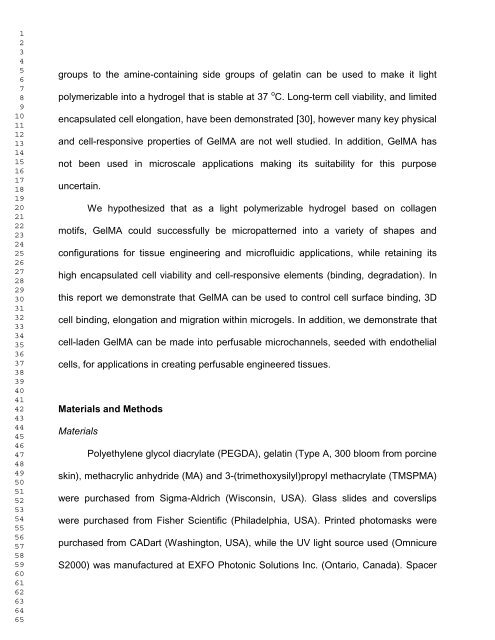Elsevier Editorial System(tm) for Biomaterials Manuscript Draft ...
Elsevier Editorial System(tm) for Biomaterials Manuscript Draft ...
Elsevier Editorial System(tm) for Biomaterials Manuscript Draft ...
You also want an ePaper? Increase the reach of your titles
YUMPU automatically turns print PDFs into web optimized ePapers that Google loves.
1<br />
2<br />
3<br />
4<br />
5<br />
6<br />
7<br />
8<br />
9<br />
10<br />
11<br />
12<br />
13<br />
14<br />
15<br />
16<br />
17<br />
18<br />
19<br />
20<br />
21<br />
22<br />
23<br />
24<br />
25<br />
26<br />
27<br />
28<br />
29<br />
30<br />
31<br />
32<br />
33<br />
34<br />
35<br />
36<br />
37<br />
38<br />
39<br />
40<br />
41<br />
42<br />
43<br />
44<br />
45<br />
46<br />
47<br />
48<br />
49<br />
50<br />
51<br />
52<br />
53<br />
54<br />
55<br />
56<br />
57<br />
58<br />
59<br />
60<br />
61<br />
62<br />
63<br />
64<br />
65<br />
groups to the amine-containing side groups of gelatin can be used to make it light<br />
polymerizable into a hydrogel that is stable at 37 o C. Long-term cell viability, and limited<br />
encapsulated cell elongation, have been demonstrated [30], however many key physical<br />
and cell-responsive properties of GelMA are not well studied. In addition, GelMA has<br />
not been used in microscale applications making its suitability <strong>for</strong> this purpose<br />
uncertain.<br />
We hypothesized that as a light polymerizable hydrogel based on collagen<br />
motifs, GelMA could successfully be micropatterned into a variety of shapes and<br />
configurations <strong>for</strong> tissue engineering and microfluidic applications, while retaining its<br />
high encapsulated cell viability and cell-responsive elements (binding, degradation). In<br />
this report we demonstrate that GelMA can be used to control cell surface binding, 3D<br />
cell binding, elongation and migration within microgels. In addition, we demonstrate that<br />
cell-laden GelMA can be made into perfusable microchannels, seeded with endothelial<br />
cells, <strong>for</strong> applications in creating perfusable engineered tissues.<br />
Materials and Methods<br />
Materials<br />
Polyethylene glycol diacrylate (PEGDA), gelatin (Type A, 300 bloom from porcine<br />
skin), methacrylic anhydride (MA) and 3-(trimethoxysilyl)propyl methacrylate (TMSPMA)<br />
were purchased from Sigma-Aldrich (Wisconsin, USA). Glass slides and coverslips<br />
were purchased from Fisher Scientific (Philadelphia, USA). Printed photomasks were<br />
purchased from CADart (Washington, USA), while the UV light source used (Omnicure<br />
S2000) was manufactured at EXFO Photonic Solutions Inc. (Ontario, Canada). Spacer


